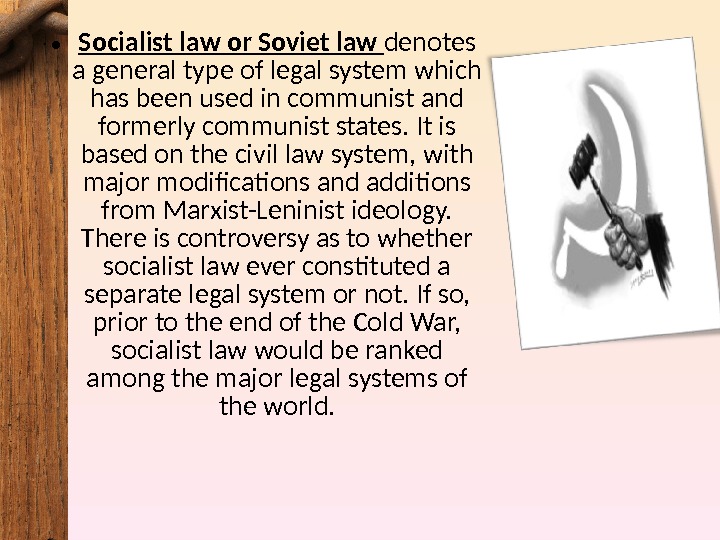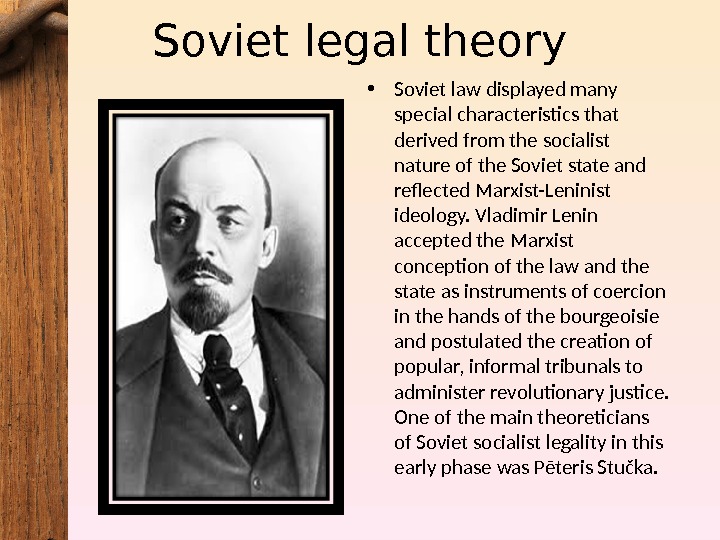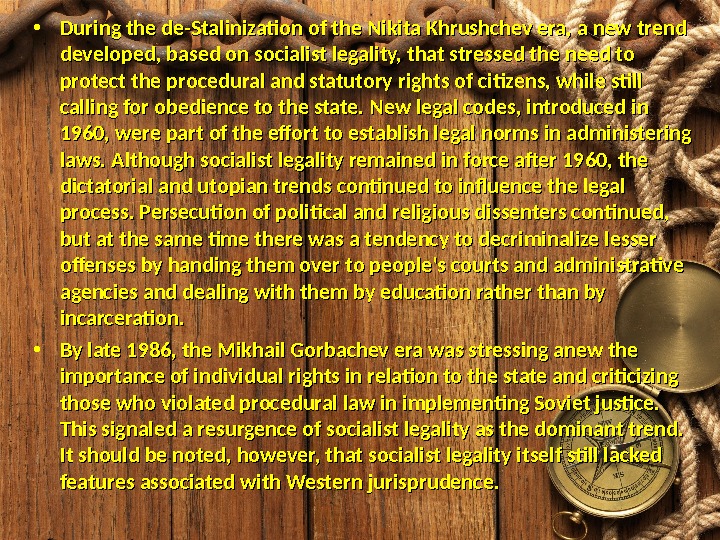SOCIALIST LAW • Socialist law









- Размер: 3.9 Mегабайта
- Количество слайдов: 9
Описание презентации SOCIALIST LAW • Socialist law по слайдам
 SOCIALIST LAW
SOCIALIST LAW
 • Socialist law or Soviet law denotes a general type of legal system which has been used in communist and formerly communist states. It is based on the civil law system, with major modifications and additions from Marxist-Leninist ideology. There is controversy as to whether socialist law ever constituted a separate legal system or not. If so, prior to the end of the Cold War, socialist law would be ranked among the major legal systems of the world.
• Socialist law or Soviet law denotes a general type of legal system which has been used in communist and formerly communist states. It is based on the civil law system, with major modifications and additions from Marxist-Leninist ideology. There is controversy as to whether socialist law ever constituted a separate legal system or not. If so, prior to the end of the Cold War, socialist law would be ranked among the major legal systems of the world.
 Soviet legal theory • Soviet law displayed many special characteristics that derived from the socialist nature of the Soviet state and reflected Marxist-Leninist ideology. Vladimir Lenin accepted the Marxist conception of the law and the state as instruments of coercion in the hands of the bourgeoisie and postulated the creation of popular, informal tribunals to administer revolutionary justice. One of the main theoreticians of Soviet socialist legality in this early phase was Pēteris Stučka.
Soviet legal theory • Soviet law displayed many special characteristics that derived from the socialist nature of the Soviet state and reflected Marxist-Leninist ideology. Vladimir Lenin accepted the Marxist conception of the law and the state as instruments of coercion in the hands of the bourgeoisie and postulated the creation of popular, informal tribunals to administer revolutionary justice. One of the main theoreticians of Soviet socialist legality in this early phase was Pēteris Stučka.
 • Alongside this utopian trend was one more critical of the concept of «proletarian justice», represented by Evgeny Pashukanis. A dictatorial trend developed that advocated the use of law and legal institutions to suppress all opposition to the regime. This trend reached its zenith under Joseph Stalin with the ascendancy of Andrey Vyshinsky, when the administration of justice was carried out mainly by the security police in special tribunals.
• Alongside this utopian trend was one more critical of the concept of «proletarian justice», represented by Evgeny Pashukanis. A dictatorial trend developed that advocated the use of law and legal institutions to suppress all opposition to the regime. This trend reached its zenith under Joseph Stalin with the ascendancy of Andrey Vyshinsky, when the administration of justice was carried out mainly by the security police in special tribunals.
 • During the de-Stalinization of the Nikita Khrushchev era, a new trend developed, based on socialist legality, that stressed the need to protect the procedural and statutory rights of citizens, while still calling for obedience to the state. New legal codes, introduced in 1960, were part of the effort to establish legal norms in administering laws. Although socialist legality remained in force after 1960, the dictatorial and utopian trends continued to influence the legal process. Persecution of political and religious dissenters continued, but at the same time there was a tendency to decriminalize lesser offenses by handing them over to people’s courts and administrative agencies and dealing with them by education rather than by incarceration. • By late 1986, the Mikhail Gorbachev era was stressing anew the importance of individual rights in relation to the state and criticizing those who violated procedural law in implementing Soviet justice. This signaled a resurgence of socialist legality as the dominant trend. It should be noted, however, that socialist legality itself still lacked features associated with Western jurisprudence.
• During the de-Stalinization of the Nikita Khrushchev era, a new trend developed, based on socialist legality, that stressed the need to protect the procedural and statutory rights of citizens, while still calling for obedience to the state. New legal codes, introduced in 1960, were part of the effort to establish legal norms in administering laws. Although socialist legality remained in force after 1960, the dictatorial and utopian trends continued to influence the legal process. Persecution of political and religious dissenters continued, but at the same time there was a tendency to decriminalize lesser offenses by handing them over to people’s courts and administrative agencies and dealing with them by education rather than by incarceration. • By late 1986, the Mikhail Gorbachev era was stressing anew the importance of individual rights in relation to the state and criticizing those who violated procedural law in implementing Soviet justice. This signaled a resurgence of socialist legality as the dominant trend. It should be noted, however, that socialist legality itself still lacked features associated with Western jurisprudence.
 Socialist law is similar to common law or civil law but with a greatly increased public law sector and decreased private law sector.
Socialist law is similar to common law or civil law but with a greatly increased public law sector and decreased private law sector.

 Principles and policies • Law subordinate to the Communist Party • From the time of the revolution until Gorbachev’s reforms, all aspects of the Soviet legal system were effectively subordinate to the leadership of the Soviet Communist Party. Legislation was debated and approved by top party leaders and then transmitted to the Supreme Soviet, the Soviet Union’s legislature, for unanimous rubber-stamp approval. • The court system was designed to ensure party control of judicial decisions at all levels. • Juries—which had shown considerable independence under the tsars—were abolished, replaced by a trial court consisting of a judge, who was selected by party officials and who almost always was a party member, and two carefully chosen laypersons, who were under pressure to agree with the judge. The system was designed to give the outward appearance of popular participation without actually involving it. Control over judicial decisions also was exercised by allowing easy appeals through higher judicial levels to the supreme courts of the Soviet republics and the Supreme Court of the Soviet Union • The centuries-old Russian institution of the procuracy was revived, creating a nationwide organization that was responsible for ensuring the enforcement of the laws and regulations and that reported directly to the party leadership.
Principles and policies • Law subordinate to the Communist Party • From the time of the revolution until Gorbachev’s reforms, all aspects of the Soviet legal system were effectively subordinate to the leadership of the Soviet Communist Party. Legislation was debated and approved by top party leaders and then transmitted to the Supreme Soviet, the Soviet Union’s legislature, for unanimous rubber-stamp approval. • The court system was designed to ensure party control of judicial decisions at all levels. • Juries—which had shown considerable independence under the tsars—were abolished, replaced by a trial court consisting of a judge, who was selected by party officials and who almost always was a party member, and two carefully chosen laypersons, who were under pressure to agree with the judge. The system was designed to give the outward appearance of popular participation without actually involving it. Control over judicial decisions also was exercised by allowing easy appeals through higher judicial levels to the supreme courts of the Soviet republics and the Supreme Court of the Soviet Union • The centuries-old Russian institution of the procuracy was revived, creating a nationwide organization that was responsible for ensuring the enforcement of the laws and regulations and that reported directly to the party leadership.
 • Public ownership of the means of production was a key feature that distinguished Soviet law from the law of most other dictatorial police states. The law distinguished between socialist property and individually owned private property. Socialist property included two subcategories—state property and collective, or cooperative, property— both of which were subject to virtually identical regimes of central economic planning. The system of private property included consumer goods, automobiles, houses, and agricultural implements for the very limited private farming that was allowed. The established property scheme formed the basis for propaganda claiming that Marx’s socialist ideals had been realized. It also facilitated the long-term maintenance of power and privilege. Because of the state’s monopoly on property, private institutions could not arise to challenge the regime. The government confiscated all houses of worship and made them available for use only to those religious organizations that posed no threat to the state. The state also owned all mass-media outlets.
• Public ownership of the means of production was a key feature that distinguished Soviet law from the law of most other dictatorial police states. The law distinguished between socialist property and individually owned private property. Socialist property included two subcategories—state property and collective, or cooperative, property— both of which were subject to virtually identical regimes of central economic planning. The system of private property included consumer goods, automobiles, houses, and agricultural implements for the very limited private farming that was allowed. The established property scheme formed the basis for propaganda claiming that Marx’s socialist ideals had been realized. It also facilitated the long-term maintenance of power and privilege. Because of the state’s monopoly on property, private institutions could not arise to challenge the regime. The government confiscated all houses of worship and made them available for use only to those religious organizations that posed no threat to the state. The state also owned all mass-media outlets.
